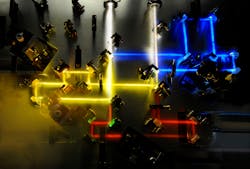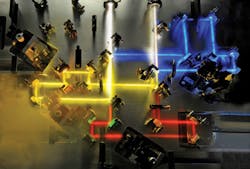ATTOSECOND PHOTONICS: Sub-femtosecond sculpted light transients probe the atom
Attosecond (as) photonics is a rapidly developing tool to help scientists study the behavior of matter and energy at this extraordinarily short time scale. Now, the group that first created 80-as light pulses has reached a new milestone: the shaping and attosecond sampling of “light transients” within a 2.4 fs time span over a 0.3–0.9 PHz frequency range. Light transients are nonrepeating sculpted waveforms that are completely confined to a single cycle, or at most a few cycles.
On-demand waveforms with customized field evolution and sub-femtosecond rise times and confinements are now possible with petahertz-scale field synthesis. These shaped transients allow physicists to probe the properties of electron behavior within atoms with great detail.
Three optical channels
In the first step in creating these transients, 25-fs-duration pulses of 780 nm light are sent through a neon-gas-filled hollow-core fiber to produce a supercontinuum. The neon is pressurized to 3.5 bars, causing spectral broadening and creating a relatively uniform energy distribution over a 330–1100 nm (greater than 0.6 PHz) bandwidth.
Creating the actual transients requires the ability to separately manipulate portions of the supercontinuum. Using chirped multilayer mirrors, the spectrum is divided into three channels: 350–500 nm, 500–700 nm, and 700–1000 nm (see figure). The mirror chirps compensate for chirp in the pulses as well as that introduced by other optics, compressing the pulses to their bandwidth-limited durations. The chirps, the carrier-envelope phases, the delays, and the pulse energies are all adjustable—which is what leads to the ability to finely sculpt the transients.
The number of channels could be increased from three if needed, says Eleftherios Goulielmakis, lead researcher with the Max Planck Institute for Quantum Optics research team (Garching, Germany). “The bandwidth of our channels corresponds to a time window of a few femtoseconds,” he notes. “Because we are seeking to control electron dynamics typically occurring within tens to thousands of attoseconds, this partition is practically sufficient. We are planning to extend synthesis over several octaves and to sculpt light fields with attosecond precision. In that case, several additional channels will be needed in order to include deep-UV, vacuum-UV, and near-IR components.”
The exiting transients are focused into a neon gas jet to produce extreme-ultraviolet radiation, which is bandpass-filtered to produce a single attosecond pulse. Both the transient and the resulting attosecond pulse (with adjustable relative delay) are then focused into another neon gas jet; a time-of-flight electron spectrometer measures the photoelectron spectra as a function of delay, revealing the shape and duration of the transient. The experimental results for light-transient sculpting agree well with predictions and are reproducible.
Using the technique as a science tool, the researchers focused the transients into a krypton-gas cell, triggering sub-femtosecond electron motion. They found that, at the leading edge of the transient, negative absorbance occurred at photon energies below the electron-transition resonances and positive absorbance above them. The absorbance profiles evolved toward a steady-state shape over time.
Further experimentation revealed the creation of a valence wavepacket. “A valence-electron wavepacket can be launched when an intense pulse is used to ionize (that is, to remove valence electrons from) the krypton atom,” says Adrian Wirth, another researcher. “Quantum-mechanically treated, this action results in ions that are in a coherent superposition of their ground state and their first excited state. This is an electronic wavepacket. Since the electronic orbitals pertinent to these states are different, the remaining electron density (or the ‘hole’ density) is evolving periodically after its triggering. This is what we can also call electron motion.”
Wirth adds that, because the light transient is sculpted in the shape of a single intense field crest, ions are created only within a small fraction of a half-cycle. As a result, the field crest that is used to trigger electron motion simultaneously provides a “time-zero” mark with respect to which the electron motion can be clocked.
Nuclear motions
“The creation and control of nuclear motions in molecules—typically evolving within tens to thousands of femtoseconds—has been the subject of femtoscience,” says Goulielmakis. “To trigger these motions, lasers were used to create coherent superpositions of vibrational quantum levels in a molecule, which are typically spaced by milli-electron volts. The spectral bandwidth of a single channel in our field synthesizer would be sufficient for exerting nuclear motion control with appropriate pulse shapers. With our new tools—that is, superoctave light-field synthesis—the vision is to drive both nuclear and electronic motions and to advance quantum control of matter to its ultimate limits.”
REFERENCE
1. A. Wirth et al., Sciencexpress, 1, 10.1126/science.1210268 (Sept. 8, 2011).
About the Author
John Wallace
Senior Technical Editor (1998-2022)
John Wallace was with Laser Focus World for nearly 25 years, retiring in late June 2022. He obtained a bachelor's degree in mechanical engineering and physics at Rutgers University and a master's in optical engineering at the University of Rochester. Before becoming an editor, John worked as an engineer at RCA, Exxon, Eastman Kodak, and GCA Corporation.


